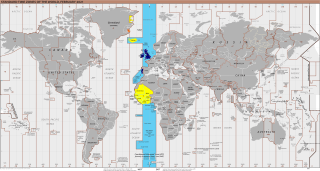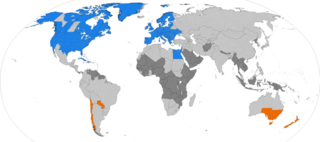Related Research Articles

Greenwich Mean Time (GMT) is the local mean time at the Royal Observatory in Greenwich, London, counted from midnight. At different times in the past, it has been calculated in different ways, including being calculated from noon; as a consequence, it cannot be used to specify a particular time unless a context is given. The term GMT is also used as one of the names for the time zone UTC+00:00 and, in UK law, is the basis for civil time in the United Kingdom.

Western European Summer Time is a summer daylight saving time scheme, 1 hour ahead of Greenwich Mean Time and Coordinated Universal Time. It is used in:

The Alaska Time Zone observes standard time by subtracting nine hours from Coordinated Universal Time (UTC−09:00). During daylight saving time its time offset is eight hours (UTC−08:00). The clock time in this zone is based on mean solar time at the 135th meridian west of the Greenwich Observatory.

Central European Time (CET) is a standard time of Central, and parts of Western Europe, which is one hour ahead of Coordinated Universal Time (UTC). The time offset from UTC can be written as UTC+01:00. It is used in most parts of Europe and in a few North African countries. CET is also known as Middle European Time and by colloquial names such as Amsterdam Time, Berlin Time, Brussels Time, Budapest Time, Madrid Time, Paris Time, Rome Time, Prague time, Warsaw Time or Romance Standard Time (RST).

Western European Time is a time zone covering parts of western Europe and consists of countries using UTC±00:00. It is one of the three standard time zones in the European Union along with Central European Time and Eastern European Time.

Summer time in Europe is the variation of standard clock time that is applied in most European countries in the period between spring and autumn, during which clocks are advanced by one hour from the time observed in the rest of the year, with a view to making the most efficient use of seasonal daylight. It corresponds to the notion and practice of daylight saving time (DST) to be found in some other parts of the world.

Central European Summer Time, sometimes referred to as Central European Daylight Time (CEDT), is the standard clock time observed during the period of summer daylight-saving in those European countries which observe Central European Time during the other part of the year. It corresponds to UTC+02:00, which makes it the same as Eastern European Time, Central Africa Time, South African Standard Time, Egypt Standard Time and Kaliningrad Time in Russia.
Time in New Zealand is divided by law into two standard time zones. The main islands use New Zealand Standard Time (NZST), 12 hours in advance of Coordinated Universal Time (UTC) / military M (Mike), while the outlying Chatham Islands use Chatham Standard Time (CHAST), 12 hours 45 minutes in advance of UTC / military M^ (Mike-Three).

Eastern European Summer Time (EEST) is one of the names of the UTC+03:00 time zone, which is 3 hours ahead of Coordinated Universal Time. It is used as a summer daylight saving time in some European and Middle Eastern countries, which makes it the same as Arabia Standard Time, East Africa Time, and Moscow Time. During the winter periods, Eastern European Time (UTC+02:00) is used.

Israel Standard Time (IST) is the standard time zone in Israel. It is two hours ahead of UTC (UTC+02:00).

Australia uses three main time zones: Australian Eastern Standard Time, Australian Central Standard Time and Australian Western Standard Time.
Time in Chile is divided into three time zones. Most of Continental Chile uses the time offset UTC−04:00 in winter time and UTC−03:00 in summer time, while the Magallanes and Chilean Antarctica region uses the time offset UTC−03:00 the whole year. Additionally, Easter Island uses the time offset UTC−06:00 in winter time and UTC−05:00 in summer time.

UTC+00:00 is an identifier for a time offset from UTC of +00:00. This time zone is the basis of Coordinated Universal Time (UTC) and all other time zones are based on it. In ISO 8601, an example of the associated time would be written as 2069-01-01T12:12:34+00:00. It is also known by the following geographical or historical names:

The time zone in Germany is Central European Time and Central European Summer Time. Daylight saving time is observed from the last Sunday in March to the last Sunday in October. The doubled hour during the switch back to standard time is named 2A and 2B.

Metropolitan France uses Central European Time as its standard time, and observes Central European Summer Time from the last Sunday in March to the last Sunday in October. With its overseas territories, France uses 12 different time zones, more than any other country in the world.

Ireland uses Irish Standard Time in the summer months and Greenwich Mean Time in the winter period.

Portugal has two time zones and observes daylight saving time. Continental Portugal and Madeira use UTC+00:00, while the Azores use UTC–01:00. Daylight saving time is observed nationwide from the last Sunday in March to the last Sunday in October, when continental Portugal and Madeira advance one hour to UTC+01:00, and the Azores advances one hour to UTC+00:00.

Daylight saving time (DST), also known as summer time, is the practice of advancing clocks during part of the year, typically by one hour around spring and summer, so that daylight ends at a later time of the day. As of 2024, DST is observed in most of Europe, most of North America and parts of Africa and Asia around the Northern Hemisphere summer, and in parts of South America and Oceania around the Southern Hemisphere summer. It was also formerly observed in other areas.
Time in the Kingdom of the Netherlands is denoted by Central European Time during the winter as standard time in the Netherlands, which is one hour ahead of coordinated universal time (UTC+01:00), and Central European Summer Time (CEST) during the summer as daylight saving time, which is two hours ahead of coordinated universal time (UTC+02:00). The Caribbean Netherlands – which consist of the islands of Bonaire, Sint Eustatius and Saba – all observe Atlantic Standard Time (AST) year-round, which is four hours behind coordinated universal time (UTC−04:00).

Svalbard, an archipelago in the Arctic Ocean belonging to the Kingdom of Norway, uses Central European Time (CET) during the winter as standard time, which is one hour ahead of Coordinated Universal Time (UTC+01:00), and Central European Summer Time (CEST) during the summer as daylight saving time, which is two hours ahead of Coordinated Universal Time (UTC+02:00). This is shared with the rest of Norway, as is Svalbard's use of daylight saving time, which the territory observes annually by advancing the clock forward on the last Sunday in March and back again on the last Sunday in October. However, as Svalbard experiences midnight sun during the summer due to being located north of the Arctic Circle, it gives daylight saving time no utility, and is only observed in order to make communicating with Norway Proper more convenient. At the 74th parallel north, the midnight sun lasts 99 days and polar night 84 days, while the respective figures at the 81st parallel north are 141 and 128 days.
References
- ↑ "Moniteur Belge - Belgisch Staatsblad". www.ejustice.just.fgov.be.